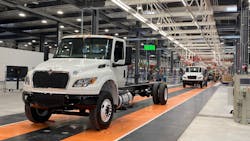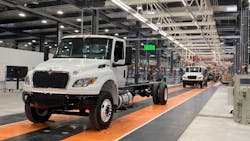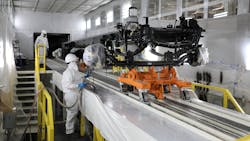Navistar opens benchmark truck production plant in San Antonio
SAN ANTONIO—Navistar is laying the foundation for its high-tech future with a new 900,000-sq.-ft. truck manufacturing plant here.
This facility will build Classes 6-8 trucks—both diesel and electric—and “frankly, anything else that the design engineers throw at us,” San Antonio plant director Rod Spencer noted during a March 23 ribbon-cutting event.
Lisle, Illinois-based Navistar, parent company of International Trucks and IC Bus, calls the $250 million investment a benchmark facility for Navistar’s manufacturing network in North America. The plant includes a body shop, paint shop, general assembly shop, and logistics center.
The first vehicle off the manufacturing line in San Antonio was the International eMV Series electric truck; the purpose of the plant from inception was to have the capability to manufacture both electric and internal combustion engine powertrains in the same facility, according to Navistar officials.
Navistar President and CEO Mathias Carlbaum pointed out that this is the first truck assembly plant in the U.S. since 1991.“This is a proud moment for Navistar,” Carlbaum said. “We are investing for a future that we see is very bright. We are ready to produce zero-emission vehicles here from day one. By 2030, we are convinced that more than 50% of the vehicles that leave this plant will be zero-emission vehicles.”
See also: Navistar chief talks future of truck technology
During a March 23 plant tour, Stephen Mudd, area director for general assembly, explained that the facility, which opened in January, is building three trucks a day. The OEM expects that, by June, when all equipment is dialed in, the plant will build 52 per day and employ 650.
The plant will serve as Navistar’s benchmark for lean manufacturing principles to eliminate waste, improve product quality, drive operational efficiency, and reduce cost and time. Industry 4.0 principles have been incorporated to connect digital and physical technologies, allowing for more connectivity and data-driven decisions.“We already know that 2022 is going to be a transformative year for the transportation industry, as well as for Navistar,” said Mark Hernandez, executive vice president of global manufacturing and logistics. “With the cloud, information, data, and digitization in our facility, we are looking at the future.”
The San Antonio Manufacturing Plant complements Navistar’s existing manufacturing footprint, which includes truck assembly plants in Springfield, Ohio, and Escobedo, Mexico; a school bus assembly plant in Tulsa, Oklahoma; and a powertrain manufacturing plant in Huntsville, Alabama.
Advanced technology, sustainability
Navistar plans to begin operations at its nearby Advanced Technology Center (ATC), accelerating the implementation of emerging technologies and Industry 4.0 technologies within the commercial trucking space. The ATC is focused on product development, testing, and validation efforts, and will be a key location for future research and development footprint with a focus on zero-emission components, software, and autonomous technologies.
Having that ATC up the road from the new plant also is an important part of the OEM’s growth overall, Hernandez explained.
“Technology is going to change in the industry immensely over the next few years, so having a location like that so close to the assembly plant will provide us with the footprint for the future for autonomy, electrification, and connected vehicles going forward,” he said.
The benchmark plant also includes a manufacturing execution system (MES) that can log all equipment defects electronically and pull various reports and information from some 60,000 different parts that go into every truck, Mudd pointed out.“The MES is what the future of a manufacturing system will look like,” Mudd said. “All our defects are logged electronically, which ensures the highest quality truck. If there is a defect logged in the system, it will not allow us to sell a truck to our customer.”
“All equipment here will be connected, as well as our information flow, so that we can react to situations on the assembly line as they happen in real time and not after we produce 50 vehicles that may have an issue,” Hernandez emphasized.
The other piece of this facility, Hernandez explained, is sustainability. The end goal for Navistar is to make this a zero-discharge facility, he said.
“Sustainable logistics is part of this,” Hernandez noted. “It’s looking at the supply chain. We want our customers to be cognizant of their carbon footprint going forward.”When it comes to sustainability, the plant will utilize on-site produced, hydrogen-fueled forklifts; multifunctional robots that constantly monitor systems and handle framing, dispensing, and welding for leaner operations; and the use of a piggable system in the paint shop. That piggable paint system forces a foam plug (the pig) through a piping network to recover maximum residual paint, allowing the facility to use only enough paint to paint trucks and eliminate waste.
During the tour, Mudd also pointed out that Navistar owns an additional 428 acres on-site so that operations could potentially double moving forward.
“We have the ability to duplicate everything we have here mirrored on the other side in the future,” Mudd explained. “As BEV capacity expands, we have the room to build a bigger plant.”About the Author

Cristina Commendatore
Cristina Commendatore is a past FleetOwner editor-in-chief. She wrote for the publication from 2015 to 2023.





